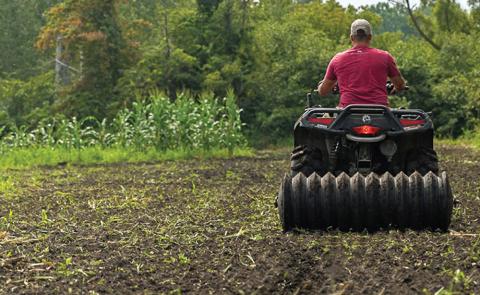Brad Mormann | Originally published in GameKeepers: Farming for Wildlife Magazine. To subscribe, click here.
Each year, we as wildlife managers busily spend the spring time planting our food plots and burning our woodlands and grasslands to encourage the growth of high quality plants. The plants we seek are those that most benefit the critter or critters we pursue each fall or observe while taking a cruise through our properties. However, for every plant we want there is a plant “we don’t want,” “we don’t think we want,” or “we really have no idea if we want” growing nearby.
At least for the “we don’t want” plants – those are called “weeds”; the “don’t think” and “have no idea” plants may or may not be a weed. It really all depends on your knowledge of plants and the animals that eat them. The important thing is that you take a closer look before jumping to conclusions and if your conclusions are right, fire at will.
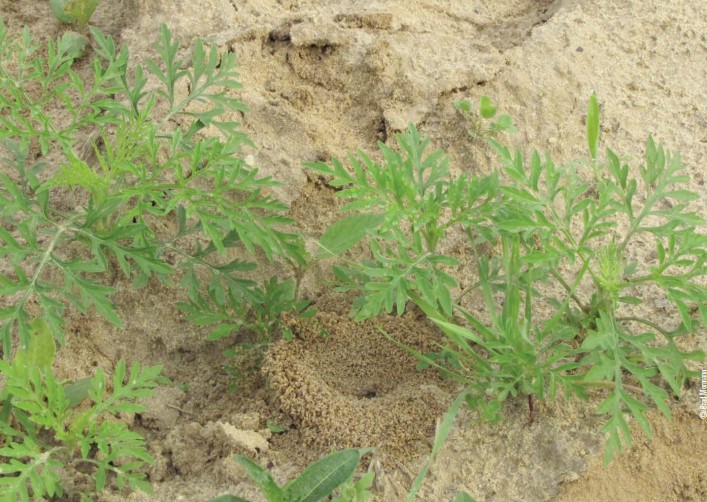
Don’t Jump to Conclusions
Is it truly a weed? Plants that appear to be weeds may be very beneficial depending on your goals. Some weeds are very nutritious, great for bedding, escape and nesting cover, and overall high on a game animal’s preference list. Just because it wasn’t something you planted or intended to grow doesn’t mean it isn’t helping your cause – diversity does have benefits. Before reaching down and pulling a plant from the ground, take a moment to figure out what it is. There are many good things that can come from identification.
Your local Natural Resources Conservation Service, Soil and Water Conservation District, and Department of Natural Resources often have plant identification books. Some even focus on common agricultural weeds. Leaving one of these in your tractor’s tool box or truck cab can be helpful when out in the field. Shoot, these days with smartphone technology greatly improving, you are carrying a huge plant database in your pocket at all times. A quick search of “Common Weeds of Iowa” (enter your state in place of Iowa) and you quickly have several picture ID listings of plants that are on the agricultural industry’s hit list. This listing can be especially beneficial in the food plot setting and when working in other disturbed areas like new CRP and tree plantings.
Once you have identified the weed, the next step is determining if it is something of value to your program. If you are looking at your deer herd’s old field bedding area, you want a mix of native warm season grass and shrubs. Even if the plant you are looking at is not a preferred grass or shrub, that’s not necessarily bad.
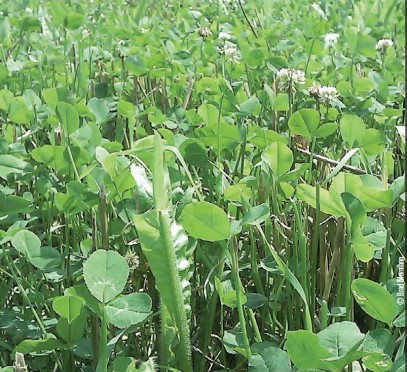
and clover food plots. This will maximize forage quality and
quantity while saving time and money.
As long as its native and not taking over, it is probably only benefiting the bedding area by adding diversity to the habitat’s structure. A diverse habitat structure allows your deer to select an ideal bed which can vary depending on if it is sunny or cloudy, calm or windy, or summer or winter. As for food plots, the next step is reviewing the critter’s preferred food list, weedy or otherwise. For deer, several beneficial and not-so-beneficial weeds are listed in Dr. Craig Harper’s “A Guide to Successful Wildlife Food Plots.” For quail the Missouri Department of Conservation has a great guide called “Quail Friendly Plants of the Midwest,” that describes both quality foods and cover that are considered weeds in other situations. There are many other great reference materials out there to fit the game species you are managing for.
Another step is to keep a watchful eye on what the critters are eating on your particular property. Two times I enjoy doing this is while sitting in the treestand and when I’m out scouting. Often from my treestand I spend my time watching does, fawns and young bucks working their way through a food plot, busily browsing as they go. Sometimes I am able to determine what they're eating with my naked eye because a mouthful of large brassica or soybean leaves is pretty obvious. Other times a set of binoculars are helpful when a variety of plants are present including both, those planted in the food plot mix and those in between.
Seeing exactly what they are consuming alleviates guessing and makes my management plan all that much more tailored to my deer herd’s needs. A follow up investigation of a particular plant they seemed to be focusing on is done as I leave the stand.
These tidbits of information are essential in learning my deer herd’s property specific foraging preferences. This type of knowledge saves a lot of time and money when instead of spraying or mowing my food plot I’m out hanging treestands or looking through trail camera pictures.
Fire at Will
With all that said; however, there will be instances when there are weedy plants that are not beneficial that are taking over your food plot or bedding and nesting areas. They may be densely populated in one portion of a field or woodland or scattered throughout. A question I often get asked is, “How the weeds got there in the first place.”
A landowner will have a food plot that had very few weeds and the next year it is overwhelmed with them. The first thing I respond with is “Have you done something different in the food plot between the two seasons?” In particular, have you disked it instead of no-till drilling it, did you start adding fertilizer, did you plant it at a different time of year, etc?
The stirring up of the topsoil by disking or other tillage operations is one of the main culprits for the mass germination of weeds. This is because many seeds have a certain depth that they will germinate at. By moving them nearer to the surface through disking, the seeds are better positioned to germinate. With many types of seeds having the ability to germinate over 50 years from when they were originally produced, the battle against weeds is seemingly endless.
Also factor in all of the critters that consume seeds and aren't able to totally digest them. Then they travel through your food plot spreading seeds in their droppings, and the battle continues. I’m sure you have seen coyote or raccoon feces filled with persimmon or other large seeds, or even turkeys scratching through cow pies to find grain. From the tractor seat I’ve even witnessed a dung beetle rolling a golf ball sized orb of feces across the woodland road I was traveling. Needless to say, my curiosity caused me to jump off the tractor to see what was going on. The little beetle was 1/5 the size of the dung ball he was rolling – busily distributing nutrients and seeds across the property.
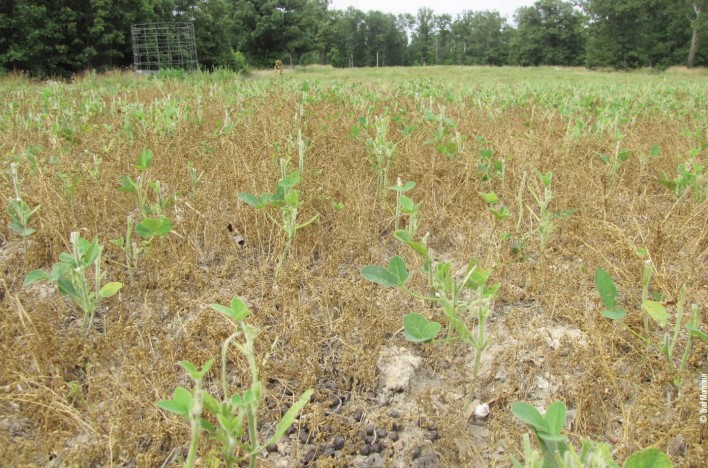
No matter how they got there, unwanted weeds can be dealt with in many ways. Important considerations are the goals of your food plot or other habitat. Do you want or need to maximize your food plot production to make the most of its availability for wildlife? In some cases maximizing a food plot’s production is essential to maintaining its productivity, especially when a deer population is moderate to high and high quality forage is in short supply.
Deer are notorious for heavy browsing pressure on high quality forage such as soybeans, chicory, and clover. Soybeans in particular do not stand up well to foraging pressure. When the pressure is high it is essential to keep unwanted weeds at bay so all of the nutrients, moisture, and sunlight available is growing new shoots and leaves as the deer relentlessly remove them. For soybeans, I like the Roundup Ready varieties that allow me to spray herbicide right over the top of them - the weeds die and soybeans thrive, at least most of the time. Unfortunately even this tried and true method is not perfect as some weeds are developing resistance. Luckily there is usually another herbicide or weed removal method out there to combat even the most resistant of weeds.
For some food plot plants and mixes I work extra hard to significantly reduce weed competition before placing a seed in the dirt. I do this because selective herbicides created to control weeds among high quality forage plants can be expensive. Also because herbicides are sometimes impractical all together when a seed mix contains a large variety of different plants. By hammering the weeds with a general herbicide once or twice before planting and limiting soil disturbance during planting the stage is set for a nearly weed free food plot. This improves the longevity of the food plot and keeps my weed maintenance costs low.
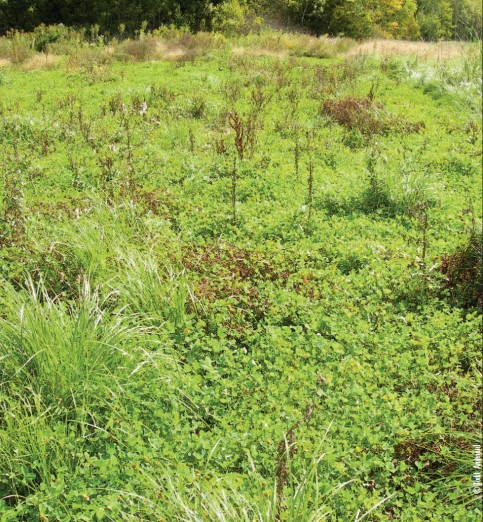
however, there is a decent stand of clover present also. This plot was
brought back by mowing and using Weed Reaper herbicide.
In the not so distant past another method was hand pulling and cutting weeds. As a kid growing up in Iowa I was often employed or “instructed” in the summer to walk the local soybean fields to rid them of velvet leaf and giant ragweed that stood as sentry’s over the fields. As you can imagine, these days that method usually is at the bottom of the list or doesn’t even make it on the list. However, in the world of a 0.25 to 0.5 acre food plot it can still be effective, especially when high energy teenagers live in your house or neighborhood.
Another method of weed control is mowing. This tactic is often used in a food plot and grassland setting to lower weed seed production and allow greater sunlight to reach beneficial plants. With more resources to work with, beneficial plants can compete more aggressively with weeds and help to keep them in check. Food plots containing a mix of clover or chicory often benefit from this method. Mowing is most effective on broad leaf weeds because it knocks off the seed heads and reduces their ability to reproduce. An occasional mowing of a clover or chicory plot can also cause the forage to go from a mature mode to a vegetative growth mode which is often more sought out by critters such as deer. This essentially allows one mowing operation to serve two purposes.
As you can see there are a few methods of controlling weeds and there is a tremendous amount of fine details that can fit under each of these methods. The application of herbicides in particular is continually evolving as old herbicides decrease in effectiveness, new herbicides are developed, and more individual plants are targeted and protected with herbicide. As our technology improves we are becoming more efficient at selecting which plants we want to grow in one place versus another. However, it is important to continually learn the preferences of your local wildlife, to not only maximize your habitat’s quality but to also save you time and money in the field. Remember, every plant can be a weed depending on where it grows.















